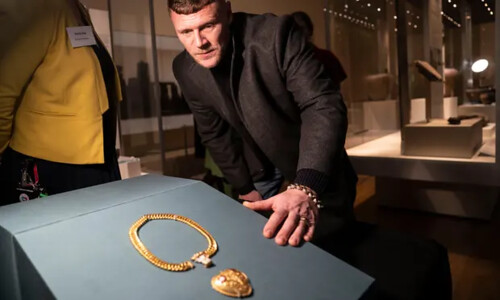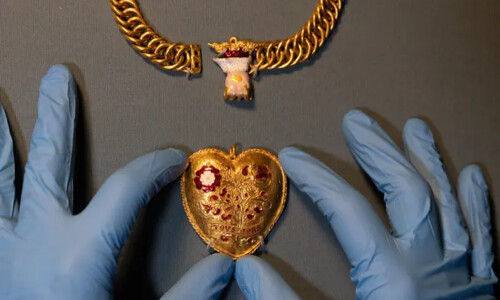
PREV ARTICLE
NEXT ARTICLE
FULL ISSUE
PREV FULL ISSUE
EARLY TUDOR GOLD PENDANT FOUNDWhile not numismatic, this Guardian article describes an amazing metal-detecting find. Thanks to Pablo Hoffman for passing this along. Just in time for Valentine's Day, it's a heart-shaped early Tudor gold pendant. -Editor
Charlie Clarke had been metal detecting for just six months when he stumbled across what he calls his What the Birmingham cafe owner had discovered was a huge and quite spectacular early Tudor pendant and chain, made in gold and enamel and bearing the initials and symbols of Henry VIII and his first wife, Katherine of Aragon. When Rachel King, curator of Renaissance Europe at the British Museum, first heard about the discovery, she had to sit down. Nothing of this size and importance from the Renaissance period had been found in Britain for more than 25 years, she said.
The heart-shaped pendant, attached to a chain of 75 links and made of 300 grams of 24-carat gold, is decorated with a bush bearing the Tudor rose and a pomegranate, Katherine's symbol, and on the reverse the initials H and K. Ribbon motifs carry the legend TOVS and IORS, which King called Despite initially seeming almost too good to be true, said King, careful scientific analysis has proved the pendant to be genuine. What experts have not been able to uncover, however, despite scouring inventories and pictures of the time, is to establish a personal link to Henry or Katherine.
One hypothesis, based on careful analysis of its iconography and other historical records, is that the pendant may have been commissioned to be worn or even given as a prize at one of the major tournaments of which Henry was so fond, around the time of the famous Field of the Cloth of Gold in 1520. Though its size suggests it would only fit a woman, it may not have been meant to be worn at all.
Nothing remotely similar survives from the period, said King. Pablo adds: "Quite a change of fortune for the lucky pendant . . . buried in dirt for centuries, now reverently handled with surgical gloves."
To read the complete article, see:
Wayne Homren, Editor The Numismatic Bibliomania Society is a non-profit organization promoting numismatic literature. See our web site at coinbooks.org. To submit items for publication in The E-Sylum, write to the Editor at this address: whomren@gmail.com To subscribe go to: https://my.binhost.com/lists/listinfo/esylum All Rights Reserved. NBS Home Page Contact the NBS webmaster 
|


